Jimsonweed
Family: Nightshade
Size: 4 inches
Date: Mid October
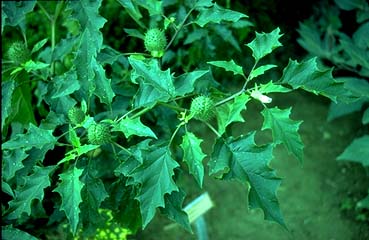 |
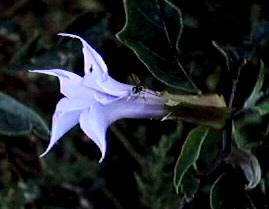 |
![]()
Datura stramonium poisoning
General poisoning notes for Datura stramonium Jimsonweed (Datura stramonium) is a naturalized annual herb found across most of southern Canada. This plant contains toxic tropane alkaloids, which have caused poisoning and death in humans and other animals. Jimsonweed is named for a case of human poisoning in Jamestown, Va., when soldiers were poisoned by eating the plant in a salad and then suffered delirium and hallucinations. The seeds and leaves are deliberately used to induce intoxication. Children are attracted by the large flowers and become poisoned after sucking the nectar from the base of flowers or ingesting the seeds. Occurrences of human poisoning are more frequent than livestock poisoning in recent literature reports. Animals of all types can be poisoned. The literature mentions poisoning of cattle, goats, horses, poultry, sheep, and swine. Because of the plant's strong odor and unpleasant taste, animals consume it only when other food is not available. The seeds are sometimes milled with other seeds and have caused problems (Cooper and Johnson 1984, Cheeke and Schull 1985, Lampe and McCann 1985).
Nomenclature
Botanical name: Datura stramonium L.
English Common name: jimsonweed
French Common name: stramoine commune
Botanical family name: Solanaceae
English family name: nightshade
Notes on poisonous plant parts
The entire plant contains alkaloids, but the leaves and seeds are the usual sources of poisoning in humans and other animals. Even the nectar of this plant contains alkaloids that contaminate honey (Cooper and Johnson 1984).
Toxic parts = all parts , flowers, leaves, mature fruit, seeds, stems
Notes on toxic chemicals
Several tropane alkaloids including hyoscyamine, hyoscine (also called scopolamine), and traces of atropine are found in the plant. The total alkaloid content in the plant varies from 0.25 to 0.7%. The alkaloids are found even in the nectar and can contaminate honey (Cooper and Johnson 1984, Cheeke and Schull 1985).
Toxic chemicals = atropine, hyoscine(scopolamine), hyoscyamine
![]()
Leaf |
Seed |
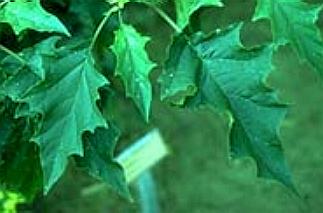 |
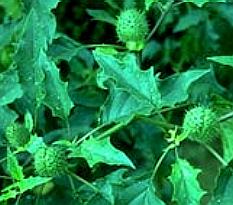 |
![]()
Scientific Name
Datura Stramonium L. - Named by Carl Linnaeus as published in Species Plantarum (1753). The genus was derived from ancient hindu word for plant, dhatura. The species name is from New Latin, stramonium, meaning thornapple. Stramonium is originally from from Greek, strychnos (nightshade) and manikos (mad).
Common Names = Jimsonweed, Jamestown weed, Thorn Apple, Downy Thornapple, Devil's Trumpet, Angel's Trumpet, Mad Apple, Stink Weed and Tolguacha
![]()
Jimsonweed is an annual herb which grows up to 5 feet tall. It has a pale geen stem with spreading branches. Leaves are ovate with green or purplish coloration , coarsely serrated along edges, and 3 to 8 inches long. Flowers are white or purple with a 5-pointed corolla up to four inches long and set on short stalks in the axils of branches. Seeds are contained in a hard, spiny capsule, about 2 inches in diameter, which splits lenghtwise into four parts when ripe.
![]()
All parts of Jimsonweed are poisonous. Leaves and seeds are the usual source of poisoning, but are rarely eaten do to its strong odor and unpleasant taste. Poisoning can occur when hungry animals are on sparse pasture with Jimsonweed infestation. Most animal poisoning results from feed contamination. Jimsonweed can be harvested with hay or silage, and subsequently poisoning occurs upon feeding the forage. Seeds can contaminate grains and is the most common poisoning which occurs in chickens.
Poisoning is more common in humans than in animals. Children can be attracted by flowers and consume Jimsonweed accidentally. In small quantities, Jimsonweed can have medicinal or haulucinagenic properties, but poisoning readily occurs because of misuse. Ingestion of Jimsonweed caused the mass poisoning of soldiers in Jamestown, Virginia in 1676.
Jimsonweed toxicity is caused by tropane alkaloids. The total alkaloid content in the plant can be as high as 0.7%. The toxic chemicals are atropine, hyoscine (also called scopolamine), and hyoscyamine.
![]()
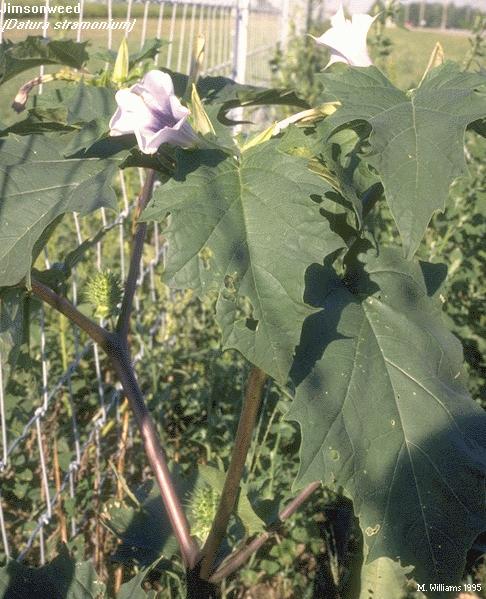
![]()
seedling |
|
| juvenile |
|
| mature |
|
| flower | 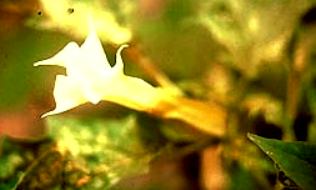 |
![]()
Datura Stramonium: "Jimson weed, Thorn Apple, Angels Trumpet" A common source for pharmaceutical alkaloids. Most common Datura species. Grows to 4' with white flower and or purple and produces a prickly seedpod. Not sold for consumption. Seeds $3
![]()
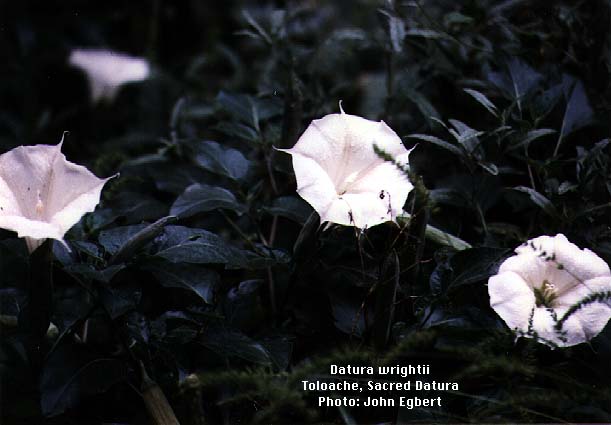
![]()
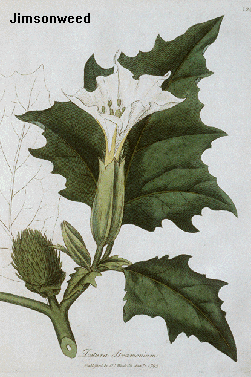
![]()
JIMSON WEED (Genus Datura) is a native of India which was imported to Europe and thence to temperate parts of North America. It name is a corruption of "Jamestown-weed", after the town in Virginia to which it is first believed to have been imported from England. Some species are annuals, others, especially the cultivated species, are deciduous shrubs. No matter; all have big, irregularly toothed leaves and funnel-shaped, purplish or white flowers which form prickly fruit. All species are poisonous, noxious weeds. If you find them growing in Nova Scotia, please contact the Department of Agriculture on 902-893-6554 for safe disposal instructions. The cultivated species of Genus Datura, known as ANGEL'S TRUMPET, look slightly different, but are just as poisonous, and also subject to Department of Agriculture control.
In ancient herbal medicine, Jimsonweed was used internally to treat madness, epilepsy, and melancholy. Externally, it formed the basis of ointments for burns and rheumatism. More recently, preparations from the plant have been used as ingredients in some asthma medicines. With this exception, however, plant is generally considered too toxic for medical applications nowadays.
Some scholars believe that vapours obtained by boiling this plant may have been used by the Delphic oracles to induce their legendary visions. More recently, in 1968, the abuse of Jimsonweed as a hallucinogenic drug prompted the US government to ban over-the- counter sales of products prepared from it.
Jimsonweed is definitely a BAD TRIP. As recently as November 9, 1995, The Arizona Republic reported the case of five, young men who tried chewing the seeds. All were rushed to hospital with alarming symptoms which persisted in three of the victims for more than two days. Their intense hallucinations included the conviction that bugs were crawling on their bodies, that they were dead, and that their body parts were strewn about the intensive care unit in which they were hospitalized. What fun...Don't mess with this plant; it's herbal Russian roulette.
If you wish to move on, CLICK on the name to return to
THE MAIN ENTRY FOR NIGHTSHADES & JIMSONWEED Poisonous Leafy Plants
The Poison Plant Guideor the gateway to The Poison Plant Patch
![]()
D. stramonium L. "Jimson weed." A green-stemmed, hairless annual, 2 to 4 feet tall, with few branches and two 8 inch long ovate leaves. The flowers are white, 4 inches long. The capsule is egg-shaped, to 2 inches long, filled with many black seeds. In D. Stramonium var. tatula the flower is violet-purple or lavender; the stems are purple. Naturalized throughout the world. They are easily grown from seeds, which sprout quickly even without bottom heat. Does well in rich soil in a dry, sunny location. May be sown in the open in May in mounds 18 inches apart with four seeds in each mound. Thin out all but the healthiest plant after sprouting.
![]()
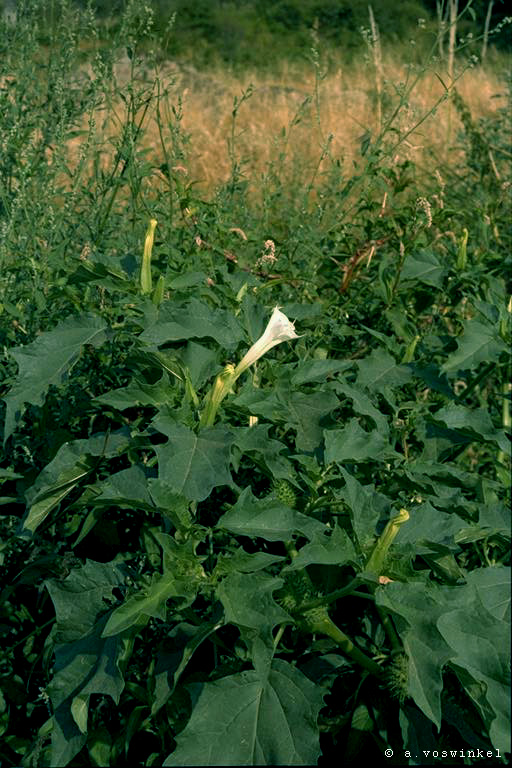
![]()
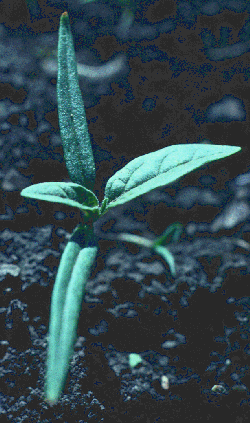
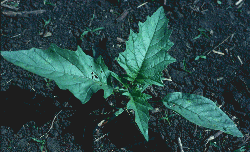
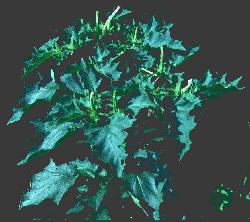
 Wildflower
Seed For Sale
Wildflower
Seed For Sale